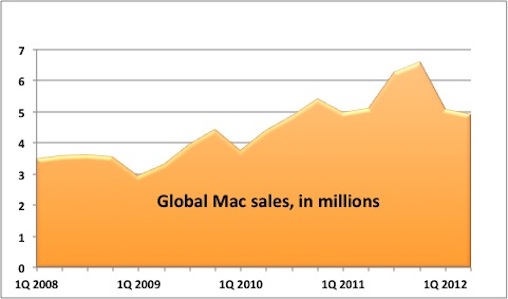Even Apple has been hit by the computer sales tailspin in the U.S., research firms IDC and Gartner said yesterday.
The two companies projected that U.S. Mac sales during the quarter ending Sept. 30 were down from the same period the year before.
IDC estimated that Apple sold 2.06 million Macs, down 7% from the 2.21 million machines sold in the same quarter of 2011. Gartner pegged the decline at 6.1% on sales of 2.08 million Macs, compared to 2.21 million the year before.
If accurate, the sales decline would be the largest by Apple since the first quarter of 2009, when Mac sales fell 8% year-over-year. That quarter was in the midst of the U.S.'s worst economic crisis since the 1930s.
There's no guarantee that either IDC's or Gartner's estimate is on target -- IDC has called ballparking U.S. sales a "very difficult exercise" in the past -- or that Apple will post negative growth numbers for worldwide sales when it releases its earnings later this month.
As proof, Apple said second quarter sales in its "American" region -- which includes the U.S., Canada, Central America and South America -- was 1.52 million Macs, a number significantly lower than either estimate last July by IDC and Gartner, who had projected U.S.-only sales of 1.81 million and 1.91 million, respectively.
"Apple is definitely the most challenging OEM [to forecast numbers for]," David Daoud, of IDC, said in an interview today.
But the figures illustrate how difficult the U.S. market is for all computer makers, including the high-flying Apple. "Absolutely, they're working in the same declining PC environment as every other OEM," said Daoud.
In the U.S., IDC estimated that PC sales were down 12.4% overall, with global sales down 8.6%. Gartner posted similar numbers: -13.8% for the U.S., -8.3% for the planet.
Even though analysts had expected a decline of some kind for the PC industry, Daoud called the magnitude of the downturn, "a big shock."
"A proliferation of factors led to this, including economic, political -- it's an election year in the U.S. -- and people waiting for [Microsoft's] Windows 8," he explained.
But Apple did better than most. Daoud, in fact, saw bright spots in the dark clouds. "The 12.5% market share Apple had in the third quarter [in the U.S.] was a record high for the past several years," said Daoud. "And if you look at sales sequentially, they've actually benefited quite a bit."
By IDC's forecast, Apple grew U.S. Mac sales nearly 14% in the third quarter over the second. Daoud cited, among other things, Apple's strong back-to-school sales.
There's a chance that PC sales will rebound in the year's last three months as Microsoft rolls out Windows 8 and OEMs debut new hardware, including a plethora of hybrid devices that combine elements of both tablets and traditional notebooks.
Apple, of course, won't see any direct Windows 8 bump, but could reap rewards if the competition -- the Hewlett-Packards and Dells of the Windows side -- stumble with their offerings.
"This is a very challenging environment for everyone," said Daoud. "Globally, it's a perfect storm. In 2009, there was still very solid consumer demand for notebooks. That's what drove the market then," he said, referring to the last time Apple posted year-over-year declines in Mac sales. "Now, it's consumers, it's businesses, it's the OEMs themselves that are pulling back."
Apple may have users that other computer makers would die for, loyal users that spend money, some times lots of it, but even they draw the line somewhere. "They're very willing customers," Daoud concluded, "but even they are spending money on other devices, like smartphones and tablets."
Apple will disclose its third-quarter Mac sales numbers Oct. 25 during an earnings call with Wall Street analysts.

Mac sales stayed steady in the second quarter, but both IDC and Gartner predict another slide in the third.





